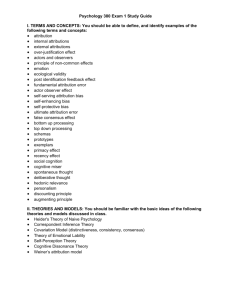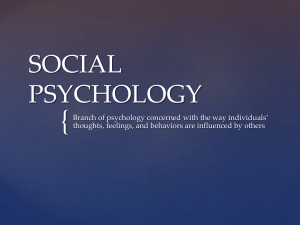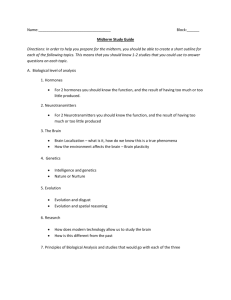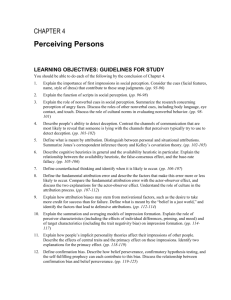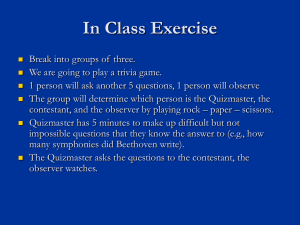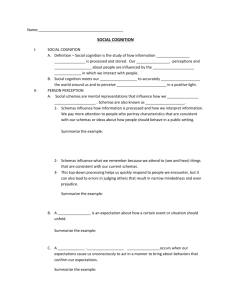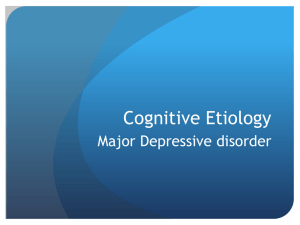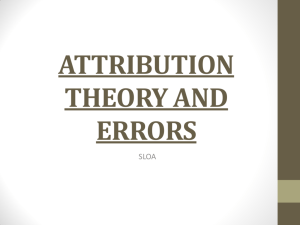Exam1studyguideF04
advertisement
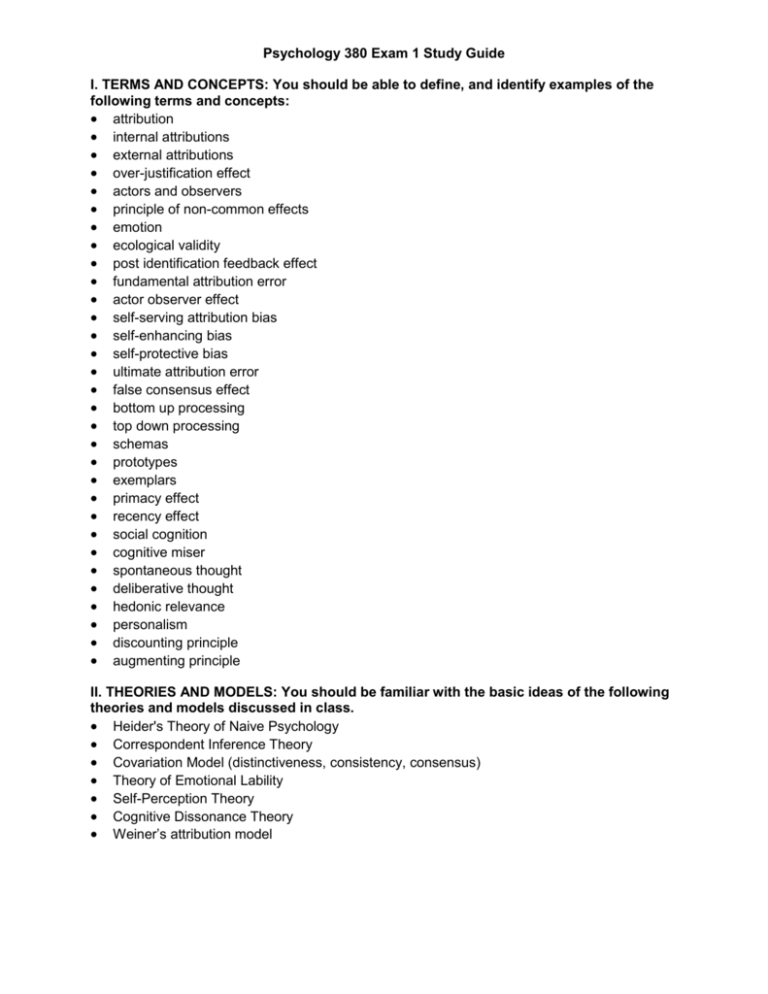
Psychology 380 Exam 1 Study Guide I. TERMS AND CONCEPTS: You should be able to define, and identify examples of the following terms and concepts: attribution internal attributions external attributions over-justification effect actors and observers principle of non-common effects emotion ecological validity post identification feedback effect fundamental attribution error actor observer effect self-serving attribution bias self-enhancing bias self-protective bias ultimate attribution error false consensus effect bottom up processing top down processing schemas prototypes exemplars primacy effect recency effect social cognition cognitive miser spontaneous thought deliberative thought hedonic relevance personalism discounting principle augmenting principle II. THEORIES AND MODELS: You should be familiar with the basic ideas of the following theories and models discussed in class. Heider's Theory of Naive Psychology Correspondent Inference Theory Covariation Model (distinctiveness, consistency, consensus) Theory of Emotional Lability Self-Perception Theory Cognitive Dissonance Theory Weiner’s attribution model III. RESEARCH STUDIES: You should be sufficiently familiar with the following studies to know the study's purpose, findings, what theory or process it examined and whether or not it supported the prediction under investigation. You will NOT be asked to recall the names of authors or years in which a study was performed. Littering Study & Math Ability Study -- Miller, Brickman & Bolen (1975) - study 1 and 2 Magic Marker Study -- Lepper, Greene & Nisbett (1975) Castro Study -- Jones & Harris (1967) Seizure Victim Study -- Nisbett & Borgida (1975) High Bridge Study -- Dutton & Aron (1974) Pill Study -- Zanna & Cooper (1974) Post Identification Feedback Study -- Wells & Bradfield (1999) Quiz Game Study -- Ross et al. (1977) Depression Study -- Lewinson et. al. (1980) Ultimate Attribution Error Study -- Chapman & von Hippel (2001) Sign Study -- Ross, Greene & House (1977) Warm-Cold Study -- Asch (1946) Racial Bias Study -- Sagar & Schofield (1980) Washing Clothes Study -- von Hippel, Jonides, Hilton & Narayan (1993) Asian Priming Study -- Gilbert & Hixon (1991) Feedback Study -- Fein & Spencer (1997) Rosch's work on typicality Racoon Study -- Kiel (1989) IV. MISCELLANEOUS ISSUES: You should be familiar with, and understand, the following ideas/questions What are the three cognitive processes involved in social cognition? Reasons that people generate attributions Heider's five levels of responsibility Controversy between self-perception theory and cognitive dissonance theory How people reduce cognitive dissonance (change, add or alter importance of attitude) What evidence suggests that the fundamental attribution error isn't universal Why do people fall prey to the fundamental attribution error Causes of self-serving biases Assumptions of the motivational explanation for the self-serving bias Reasons for the false consensus effect (motivational, cognitive) Individual differences in attributional biases (locus of control) Implications of the self-serving bias for people with internal and external locus of controls Cross-cultural perspectives on bias/error Functions of schemas What activates schemas How schemas are structured (classical view, probabilistic view) Assumptions and limitations of the classical view Assumptions of the probabilistic view How the probabilistic view accounts for the limitations of the classical view Prototype model of schemas Exemplar model of schemas Probabilistic view of schemas and the DSM Criticisms of the probabilistic view of schemas
